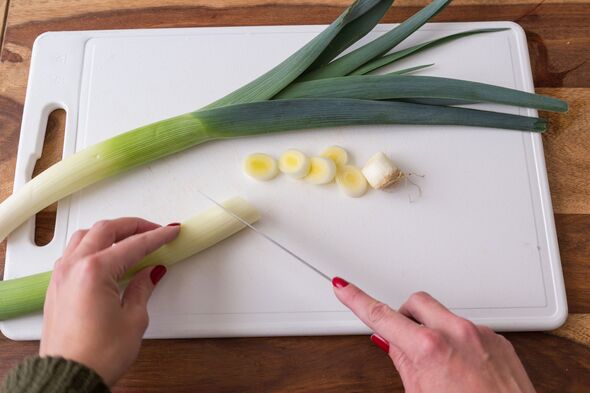Lifestyle
Food Safety Alert: Replace Scratched Chopping Boards Now

Households in the UK are being urged to replace their old chopping boards due to potential health risks. Experts from Knorr have highlighted that worn-out boards may harbour harmful bacteria and microplastics, raising concerns over food safety.
Chopping boards are vital tools in any kitchen, used for slicing vegetables and preparing meats. However, many users may not be aware that a board showing signs of wear could pose more danger than convenience. Experts advise that when a chopping board is covered in scratches, it is time for a replacement. “Bacteria love to hide inside the grooves,” Knorr representatives warned, emphasizing the importance of maintaining kitchen hygiene.
The presence of bacteria in the cuts and grooves of a chopping board can lead to rapid multiplication, increasing the risk of cross-contamination. This is a significant factor contributing to food poisoning, which remains a common concern for households.
To mitigate these risks, Knorr recommends using separate boards for raw and cooked foods, thoroughly cleaning them with hot soapy water after each use, and avoiding tea towels for drying. This guidance aims to enhance food safety practices among consumers.
In addition to bacterial risks, a recent peer-reviewed study published in Environmental Science & Technology in 2024 has raised alarms about microplastics from damaged plastic chopping boards. The research, titled “Cutting Boards: An Overlooked Source of Microplastics in Human Food?” examined boards made from materials such as polyethylene and polypropylene. Researchers discovered that scratched surfaces could release tiny plastic particles while slicing food, particularly vegetables, meat, or fish.
The study estimates that a regular user of plastic chopping boards could be exposed to approximately 50 grams of microplastics per year, roughly equivalent to the weight of a chocolate bar. Microplastics, defined as particles smaller than 5mm, are increasingly prevalent in oceans, soil, and even within the human body. Prior research has linked microplastics to inflammation, cardiovascular issues, and other long-term health concerns.
Despite these findings, experts suggest that the overall risk from cutting boards appears to be low. Dr. Manish Shetty, an assistant professor of chemical engineering at Texas A&M University, stated in an interview with NBC News that “plastic cutting boards are generally safe to use.” He noted that most microplastic particles are likely washed off during the cleaning process.
Dr. Hoaran Wei from the University of Wisconsin-Madison also commented on the study, indicating that it did not find any toxicity effects, which he described as a positive sign. While the research underscores a potential source of microplastics, he emphasized that there is no robust evidence suggesting it poses significant harm. “This is a safe process, based on what we know so far,” added Dr. Wei.
Both experts agree on the necessity of further research to fully understand the long-term health impacts of microplastics. In the interim, the advice remains clear: if your chopping board is scratched, replacing it is a prudent step, alongside adhering to basic hygiene rules to ensure safety in the kitchen.
As households reevaluate their kitchen tools, the emphasis on food safety continues to grow. By following expert recommendations, consumers can protect themselves from hidden risks in their culinary practices.
-

 Health3 months ago
Health3 months agoNeurologist Warns Excessive Use of Supplements Can Harm Brain
-

 Health4 months ago
Health4 months agoFiona Phillips’ Husband Shares Heartfelt Update on Her Alzheimer’s Journey
-

 Science2 months ago
Science2 months agoBrian Cox Addresses Claims of Alien Probe in 3I/ATLAS Discovery
-

 Science2 months ago
Science2 months agoNASA Investigates Unusual Comet 3I/ATLAS; New Findings Emerge
-

 Science2 months ago
Science2 months agoScientists Examine 3I/ATLAS: Alien Artifact or Cosmic Oddity?
-

 Entertainment2 months ago
Entertainment2 months agoLewis Cope Addresses Accusations of Dance Training Advantage
-

 Entertainment5 months ago
Entertainment5 months agoKerry Katona Discusses Future Baby Plans and Brian McFadden’s Wedding
-

 Science2 months ago
Science2 months agoNASA Investigates Speedy Object 3I/ATLAS, Sparking Speculation
-

 Entertainment5 months ago
Entertainment5 months agoEmmerdale Faces Tension as Dylan and April’s Lives Hang in the Balance
-

 World3 months ago
World3 months agoCole Palmer’s Cryptic Message to Kobbie Mainoo Following Loan Talks
-

 World4 weeks ago
World4 weeks agoBailey and Rebecca Announce Heartbreaking Split After MAFS Reunion
-

 Science2 months ago
Science2 months agoNASA Scientists Explore Origins of 3I/ATLAS, a Fast-Moving Visitor









